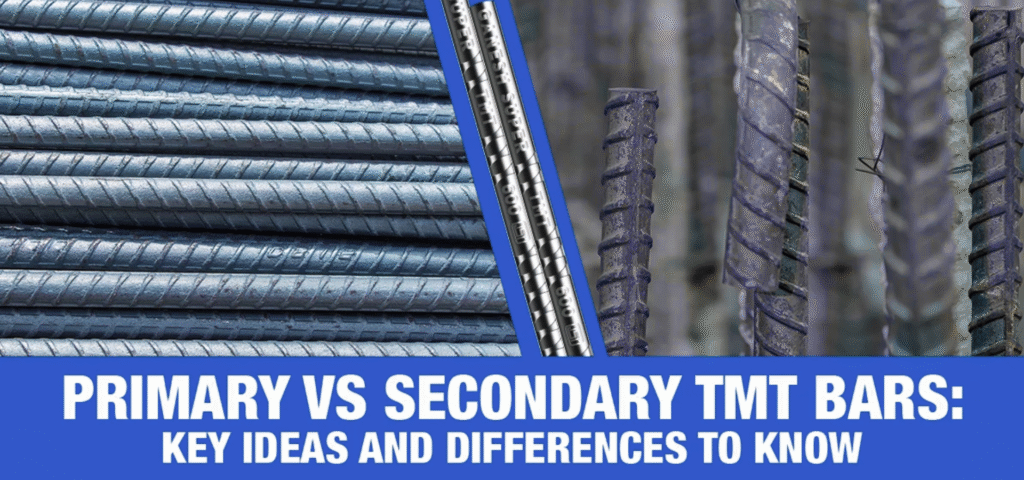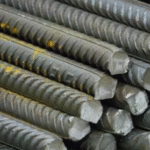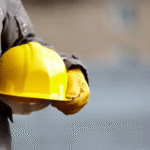Steel is one of the most essential construction materials, forming the backbone of modern infrastructure. Whether it’s for residential projects, bridges, or skyscrapers, steel quality plays a major role in durability, safety, and cost-effectiveness. Among the different classifications of steel, Primary Steel and Secondary Steel stand out as two distinct categories that every buyer, engineer, or contractor should understand.
In this comprehensive guide, we will explore the key differences between Primary Steel and Secondary Steel, their manufacturing processes, properties, advantages, disadvantages, applications, and help you make the right choice for your project.
What is Primary Steel?
Primary Steel is steel that is manufactured from virgin raw materials in integrated steel plants. It follows strict quality control measures and adheres to national and international standards (e.g., ISI, BIS, ASTM). Companies like TATA Steel, SAIL, JSW, and AM/NS produce primary steel.
Characteristics of Primary Steel:
- Produced in large integrated steel plants.
- Uses iron ore, coal, and limestone as raw materials.
- Manufactured using processes like Blast Furnace-Basic Oxygen Furnace (BF-BOF) route.
- Consistent chemical composition and mechanical properties.
- High purity, low impurities (sulphur, phosphorus, etc.).
What is Secondary Steel?
Secondary Steel is steel produced in smaller units, often using scrap or recycled steel as the main raw material. While some secondary producers maintain quality, many operate on smaller scales without the same level of technology and testing.
Characteristics of Secondary Steel :
- Produced in mini mills or secondary rolling mills.
- Uses scrap metal and sponge iron (DRI) as raw materials.
- Manufactured using Electric Arc Furnace (EAF) or Induction Furnace (IF).
- Quality and consistency vary greatly depending on the manufacturer.
- May have higher levels of impurities compared to primary steel.
Key Differences Between Primary Steel and Secondary Steel (Primary Steel vs Secondary Steel) :
| Feature | Primary Steel | Secondary Steel |
|---|---|---|
| Raw Materials | Iron ore, coal, limestone | Scrap steel, sponge iron |
| Manufacturing Units | Large integrated plants | Small/medium rolling mills |
| Technology | BF-BOF, advanced automation | EAF/IF, semi-automatic |
| Quality | Consistent, certified, meets BIS/ISI standards | Varies, may not meet standards |
| Impurities | Very low | Higher (S, P, etc.) |
| Strength & Durability | High tensile strength, uniform quality | May be inconsistent |
| Cost | Higher | Relatively cheaper |
| Applications | Large-scale projects, high-rise buildings, bridges | Small-scale constructions, non-critical structures |
Advantages of Primary Steel
✔️ High purity and strength.
✔️ Strictly tested and certified.
✔️ Suitable for critical infrastructure projects.
✔️ Longer life span and reliability.
Disadvantages :
❌ Higher cost compared to secondary steel.
❌ Longer lead times due to bulk production.
Advantages of Secondary Steel
✔️ More affordable than primary steel.
✔️ Widely available in local markets.
✔️ Uses recycled materials → environmentally friendly.
Disadvantages :
❌ Quality inconsistency.
❌ May not meet BIS or ISI standards.
❌ Risk of structural failure in long-term applications.
Primary Steel vs Secondary Steel: Strength & Performance (Chart)
Strength & Durability (out of 10)
Primary Steel ██████████ 10/10
Secondary Steel ██████ 6/10
Consistency in Quality (out of 10)
Primary Steel ██████████ 10/10
Secondary Steel █████ 5/10
Cost Affordability (out of 10)
Primary Steel ███████ 7/10
Secondary Steel ██████████ 10/10
Applications of Primary Steel
- High-rise buildings & skyscrapers.
- Bridges & flyovers.
- Dams & tunnels.
- Industrial plants & factories.
- Heavy machinery & critical components.
Applications of Secondary Steel
- Small residential houses.
- Low-cost projects.
- Temporary structures.
- Non-critical construction.
How to Identify Primary vs Secondary Steel?
- Check for BIS/ISI Marking: Primary steel always carries certification.
- Branding: Primary producers (TATA, SAIL, JSW) stamp their brand names on bars.
- Surface Finish: Primary steel has a uniform, rust-free finish.
- Pricing: If the price is too low compared to the market average, it’s likely secondary.
Which One Should You Choose?
- If you are building large projects, multi-storey structures, or anything that demands safety and durability, always go for Primary Steel.
- If the project is small, temporary, or budget-constrained, Secondary Steel can be considered, but with caution.
✅ Final Verdict
When it comes to steel, quality should never be compromised. Primary steel, despite being more expensive, offers the strength, safety, and longevity that construction projects demand. Secondary steel has its place in low-cost and non-critical applications, but for long-term investments, Primary Steel is the clear winner.
📌 FAQs on Primary Steel vs Secondary Steel
1. What is the difference between primary steel and secondary steel?
Primary steel is manufactured directly from iron ore using blast furnace or basic oxygen furnace technology, whereas secondary steel is produced from recycling scrap steel through electric arc furnaces. For genuine and high-quality steel, contact Pahari Home Solutions Pvt. Ltd. – Call us at +91 7584055356.
2. Which is stronger : primary steel or secondary steel?
Primary steel is usually considered stronger because it is produced from raw materials with advanced refining processes. Secondary steel strength may vary depending on the quality of scrap used. To choose the right steel for your project, contact Pahari Home Solutions Pvt. Ltd. at +91 7584055356.
3. Is primary steel more expensive than secondary steel?
Yes, primary steel generally costs more due to higher production costs and superior quality, while secondary steel is cheaper. For competitive prices on both, contact Pahari Home Solutions Pvt. Ltd. at +91 7584055356.
4. Which steel is better for home construction?
Primary steel is recommended for home construction because of its superior strength, uniformity, and durability. For the best deals on TMT bars and construction steel, call Pahari Home Solutions Pvt. Ltd. at +91 7584055356.
5. Can secondary steel be used for construction?
Yes, but it is more suitable for non-structural applications or projects where cost is a bigger concern than durability. For expert guidance, contact Pahari Home Solutions Pvt. Ltd. at +91 7584055356.
6. Why is primary steel called “virgin steel”?
It is called virgin steel because it is made from iron ore directly and not recycled materials. To get authentic virgin steel, contact Pahari Home Solutions Pvt. Ltd. at +91 7584055356.
7. Is secondary steel eco-friendly?
Yes, secondary steel is more eco-friendly as it recycles scrap, reducing the need for raw material extraction. For eco-friendly construction material options, contact Pahari Home Solutions Pvt. Ltd. at +91 7584055356.
8. Which steel has better consistency in quality?
Primary steel offers better consistency as it follows strict refining standards, unlike secondary steel where quality depends on scrap material. For consistent steel supply, contact Pahari Home Solutions Pvt. Ltd. at +91 7584055356.
9. Which steel is more corrosion-resistant?
Primary steel is generally more corrosion-resistant due to better control during production. To purchase corrosion-resistant steel, call Pahari Home Solutions Pvt. Ltd. at +91 7584055356.
10. Is secondary steel safe for RCC construction?
It depends on the grade and testing. Certified secondary steel may be safe, but primary steel is always a safer choice. For RCC steel guidance, contact Pahari Home Solutions Pvt. Ltd. at +91 7584055356.
11. Does primary steel have a longer lifespan than secondary steel?
Yes, primary steel usually lasts longer due to its uniform chemical composition and strength. To get long-lasting construction materials, call Pahari Home Solutions Pvt. Ltd. at +91 7584055356.
12. Is secondary steel cheaper because of lower quality?
Secondary steel is cheaper mainly because it uses recycled materials and less energy in production, but quality depends on the source. For affordable steel options, contact Pahari Home Solutions Pvt. Ltd. at +91 7584055356.
13. Which steel is preferred in high-rise buildings?
Primary steel is preferred for high-rise buildings due to its reliability and strength. For steel supply for skyscrapers and big projects, contact Pahari Home Solutions Pvt. Ltd. at +91 7584055356.
14. Is there any difference in weight between primary and secondary steel?
No significant weight difference exists; the difference lies in quality and composition. To get properly certified steel weights, contact Pahari Home Solutions Pvt. Ltd. at +91 7584055356.
15. Which industries use secondary steel more?
Secondary steel is often used in automobile parts, roofing sheets, and small construction projects. For industrial steel supply, call Pahari Home Solutions Pvt. Ltd. at +91 7584055356.
16. Can I mix primary and secondary steel in a single project?
It is not advisable to mix them in structural projects due to strength inconsistencies. For expert project consultation, contact Pahari Home Solutions Pvt. Ltd. at +91 7584055356.
17. Which steel has better earthquake resistance
Primary steel, especially TMT bars, offers superior earthquake resistance. For earthquake-resistant TMT bars, contact Pahari Home Solutions Pvt. Ltd. at +91 7584055356.
18. Does BIS certification apply to both primary and secondary steel?
Yes, both can be BIS-certified if they meet quality standards. To buy BIS-certified steel, contact Pahari Home Solutions Pvt. Ltd. at +91 7584055356.
19. Is primary steel always branded and secondary steel unbranded?
Mostly yes. Primary steel is manufactured by big brands like TATA, SAIL, JSW, while secondary steel is often produced by local mills. For both branded and affordable steel options, contact Pahari Home Solutions Pvt. Ltd. at +91 7584055356.
20. Where can I buy primary and secondary steel in Medinipur and nearby areas?
You can buy both from Pahari Home Solutions Pvt. Ltd., your trusted supplier for construction materials. 📞 Call us now at +91 7584055356 for orders and delivery.
📌 Conclusion
Understanding the difference between Primary and Secondary Steel is crucial for making informed construction decisions. While secondary steel may save money upfront, primary steel ensures safety, durability, and peace of mind for decades. Always check for certifications, brand markings, and BIS/ISI approval before making a purchase.



